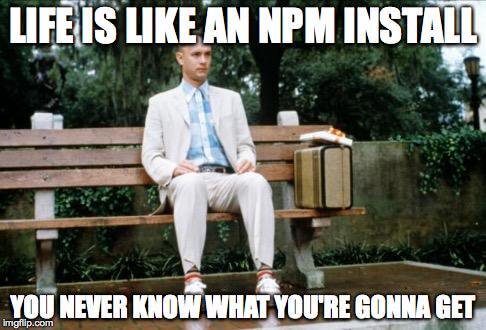How to Install Nod_modules Only Again
At that place are two master methods of arranging JavaScript code – via a library construction or through a framework. But if you go deeper, y'all'll discover that the code is often constructed in a way that results in a module.
A module is a functionality that tin can exist imported or exported. Sometimes it comes along in the form of 3rd party libraries. Sometimes it comes bundled with the framework y'all're using.
Modules can be used in various parts of an application, bundled into or excluded in builds. However they are used and implemented, a module is essentially i of the many lego-like bricks that make up the pre-built functionalities of your application.
What are node modules and how do you lot utilise them?
Node.js is a server runtime surround that runs JavaScript outside of a browser. Despite popular conventionalities, node.js itself is not a framework. Rather, it's the thing that allows frameworks and libraries to run.
For frontend applications, you can run a JavaScript application without a server by just opening the browser, in addition to a lot of manual configuration. Backend apps need a runtime environment to run.
Backend apps without an interface frequently come in the course of APIs or collaborate with the database.
Then, what exactly are modules?
Modules are clusters of code that are grouped based on functionality. They are highly cocky-contained, making them highly reusable and contained from one another.
When information technology comes to code, a way to import modules into your project is to utilise the crave() function.
For example, to implement the third-party HTTP server module limited, you lot tin can do so via your console. The node_modules folder is the default folder where all your third-party libraries are downloaded to and served from.
To install, merely npm it.
npm install limited
To import, create a const and call it in via require()
const limited = require('limited');
To reference and use express, you can do so by initializing it.
const app = express() app.get('/', role(req, res) { res.send('Hello TabNine') }) app.listen(3000) 
The functionality of package.json
Earlier we talk well-nigh the purpose and functionality of package.json, we demand to take a clear understanding of npm.
npm is ane of those things we use only may not really know exactly what it does.
So what is npm?
npm is a parcel manager.
A package managing director is a piece of software that automates the installation, upgrading, configuring and removing things from the space it covers. For npm, this means installing, upgrading, configuring and removing libraries and frameworks, in add-on to kickstarting runtimes like node.js via npm commands.
It saves yous from manually having to code in all the different pathways and dependencies requires to make your JavaScript awarding run.
Where does package.json come in?
package.json is a json file that npm uses by default to identify the project and handle all the declared dependencies. Information technology is used every bit a starting point by npm and the data contained in this file to fetch and coordinate the various JavaScript libraries (packages) required past an application to run.
You tin can create a bundle.json file via the console using npm init
When you run this command, information technology will give you a series of questions to respond via the panel and generate a json file that contains a name, version, description, chief (the entry indicate of your awarding), any scripts, the writer, and license type.
If you decided not to answer the questions in the console and come dorsum to it after, your package.json file should look something like this:
{ "proper name": "tabnine", "version": "i.0.0", "clarification": "", "main": "index.js", "scripts": { "test": "repeat \"Error: no examination specified\" && exit 1" }, "author": "", "license": "ISC" } By default, alphabetize.js is set up as the main, but you lot can have it be whatever you lot desire.
How to add node modules into packet.json
To add together 3rd-party modules into packet.json automatically, run the --save flag when you install the module.
For example, in the above case, we used installed express for our project using npm. To accept it added to our package.json, add together the --save flag at the end.
npm install express --save
The --save flag essentially tells npm to save limited as a dependency. If information technology doesn't exist, it volition create a new dependencies object in your parcel.json file that looks something like this:
"dependencies": { "express": "^iv.17.ane" } Otherwise, npm will just add it to the dependencies object. By default, npm will look to your node_module folder to find the dependencies.
You tin also use --salve-dev to make a particular module only available in the development environment. When you lot apply --salvage-dev, information technology will create or add to the devDependencies object, in the same manner as it did with dependencies and --save.

Why is this important?
The dependencies object makes information technology possible to share lawmaking in an elegant and efficient manner. npm plays a pivotal role in keeping rail of dependencies and version used. When you push and share lawmaking in a team setting via git, you're only making the code created by your squad available.
This saves you download and upload fourth dimension, and coordinating betwixt transmission updates. To install and instantiate a working project on your local machine, you only need to pull the code and run npm install.
The bundle director will utilize the meta-data inside packet.json and effigy out the remainder for you.
npm, however, is not the just package managing director bachelor. In 2016, Facebook announced the release of Yarn, a packet management customer that runs of the npm registry.
The npm registry is a complimentary and public registry for JavaScript modules. Since so, Yarn has become another major and widely used package manager. Yarn is backward compatible and follows the conventions set by npm for the package.json file.
This means yous don't take to worry if the dependencies object is chosen something else.
What about putting your node modules in a different folder?
There are times where you may non want the modules to download into the node_module folder. Whatever the reason, at that place is no way to change it in npm as it is function of node.js' core module loading system. If yous were to change it globally, it may cause your packages to intermission.
Nonetheless, yarn gives you the option to configure it. To do this, run the post-obit command:
yarn install --modules-folder <path>
The package manager will do the heavy lifting required to brand everything work smoothly. Alternatively, if yous don't desire to go on specifying the path every time, you lot tin can create a file called .yarnrc with the post-obit as a configuration.
# ./.yarnrc
--modules-folder lib
When you run yarn install, information technology will create a lib binder and install packages to information technology instead of node_modules.
Conclusion
Modules are foundational to edifice robust and reusable lawmaking.
Virtually major frameworks accept a command-line interface that you lot can install via npm to scaffold out a barebone application such equally the Athwart CLI and Vue CLI. These generators will automatically create a package.json for yous with the required dependencies to make things run smoothly.
For this reason, a lot of new developers tend to miss out on learning the importance of package.json and how it functions. Generators ofttimes take abroad the complication of setting up and make the task of app development faster and more robust by generating scaffold lawmaking that's modeled on an accepted standard.
packet.json is a elementary file that has the potential to turn complex as it grows. The dependencies object is merely a small portion of what information technology can do and covers the telescopic of this article.
In theory, you can manually add each dependency yourself simply using a package manager such as npm and yarn just makes your development menses a lot faster and easier. It besides cuts downward the potential for mistakes and errors.
Source: https://www.tabnine.com/blog/node-modules-package-json/
Post a Comment for "How to Install Nod_modules Only Again"